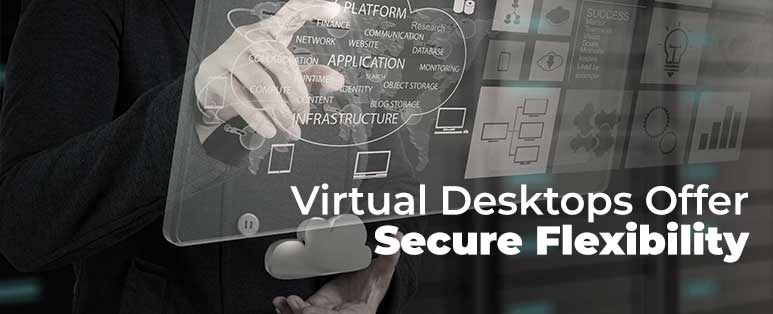
VDI didn’t change the Internet, it changed the way we are using it. Traveling with a laptop has never been easier. Remote access to corporate resources has never been easier and businesses can save millions on infrastructure with one VDI installation. By simply purchasing or deploying a virtual desktop environment (VDI), end users are able to work anywhere and anytime; this innovative technology improves productivity while dramatically decreasing IT red tape.
VDI comes with a lot of fear. Cybersecurity, malware, phishing, data theft, and privacy laws have businesses worried about compliance. It’s becoming more important than ever to stay ahead of the curve when it comes to data security and protection. The more growth your organization has, the more systems you have that need to be secured. Virtual desktop services (VDS) are an excellent way to protect and store sensitive data while still allowing workers to access them conveniently from anywhere in the world. These solutions allow organizations to achieve a balance between regulatory compliance and employee productivity.
As regulations evolve; particularly surrounding financial data where security incidents frequently take place, businesses seek solutions that incorporate standardization and consistency to support compliance. This is where virtual desktop infrastructure (VDI) play an important role.
With VDI, a desktop computer runs on a virtual machine (VM) that lives in the cloud or data center. A virtual machine is an “instance” of a computer program running on hardware controlled by a software system, such as a Windows, Linux, or iOS operating system. The interface of the virtual experience is identical to having a traditional desktop computer. Cost savings arise from manageability of inventory and software updates. Where end users require high data transfer speeds, VDI can render thin and zero clients very efficient and cost-effective as well as protect proprietary information
Organizations can benefit from a highly resilient, efficient, and extremely cost-effective platform for virtualization like hyper-converged infrastructure (HCI) which can help companies scale. Configurations are designed to easily manage peak performance demands.
The availability of enhanced GPU support enables companies to handle general purpose environments as well as those requiring quality graphics, design, rendering, or detailed visual needs. Many modern solutions make it possible to create hundreds of virtual desktops in minutes at low price points, and scaling up is simple. From a security and compliance perspective, VDI stores data on a centralized server rather than on end-user devices. As a result only a screen image is transferred to the client and not the data itself. This reduces the likelihood of a data breach arising as a result of a device being lost, stolen, or tampered with.
You’ll Get Centralized Management
A VDI deployment allows end-users to work anywhere and anytime while improving productivity as well as decreasing IT red tape. Every process is fully and centrally controlled from a secure data center. A good example is bank employees are capable of remaining connected and accessing the network as well as resources irrespective of location. Every process is fully and centrally controlled from a secure data center. They can switch teller stations quickly, fill in at a secondary location or access accounts off-site in case of emergency.
Virtualization allows them to access the necessary files, tools, and data from any computer. This type of infrastructure and platform allows banks to expand and scale quickly as staffing needs fluctuate, locations scale up and grow or perhaps move to new real estate locations.
Rather than send the bank employee home with a laptop which has multiple insecure access points, the employee can utilize a thin or zero client which if lost or stolen is very low in price point and contains no actual data. A thin or zero client can be set up to deny screen shots, downloads, or printing so the employee cannot inadvertently or purposefully save information.
IT can effortlessly apply software updates and patches, modify configurations, and enforce policies for all virtualized desktops across the environment. Administrators can centrally manage any remote desktop service hosted on a data center, hyper-converged platforms, or cloud servers, with the ability to assign specific licenses for each user role. Upgrades are easier, less time-consuming, and one gets to enforce organization-wide data integrity as user information is backed up regularly and centrally.
Difficult processes such as account reconciliation, security training, and on-boarding can be done from any device while streamlining procedures. VDI refers to a technology that enables users to access applications and data remotely from any device — on premise or off-site. SaaS solutions or cloud-based applications provide similar virtual access to resources.
You Can Control the Digital Workspace
An employee remotely accessing a VDI solution from their endpoint can manage the OS and apps on it as if they are running locally. All of the data from a VDI connection resides on the central server, so if an endpoint is lost, misplaced, or stolen, there is nothing to extract from its local storage. This setup allows users to safely access everything they need from practically any device without requiring specific hardware. Virtual desktops are further supported by solutions that integrate extensive authentication, convenient Single Sign-On (SSO) and secure remote access capabilities. IT can easily run and manage them together with the growing spectrum of mobile, web, and cloud apps that are crucial components of modern workloads.
In the context of digital workspace, employees benefit from a unified experience that improves productivity. At the same time, administrators get to avoid silo and reduce the risk of unauthorized logins, two key VDI security best practices. All this contributes to a dynamic working environment with end user satisfaction.
You can apply kiosk applications on top of the operating system to further control what programs can and cannot be accessed while logged in.
Virtual Desktop Infrastructure is True Flexibility
Virtual Desktop Infrastructure is the key to reducing the number of devices in use. Not only does it cut down on support costs by providing a single point of contact for devices, but it also saves on shipping and storage costs.
This integrated approach works well and support affordable office layouts, remote working, and hybrid working. Calls can be automatically rerouted to a relevant phone number quickly and users do not have to carry expensive workstations or laptops that contain sensitive information.
Employees connect remotely to the company’s data through 3G, 4G, 5G or Wi-Fi. All data is consistently stored and managed within the corporate infrastructure. Blending this flexibility with the low support costs and enhanced security leads the way to a practical and feasible strategy that allows users to work from home as needed.
Be Ready to Pivot
In these uncertain times, businesses cannot afford to put data security at risk, and companies need to be flexible when it comes to infrastructure management. Opting for a virtual desktop setup is a reasonable and secure investment that a business can make with a guaranteed return on investment in the long run.
As a brand you have to modernize and adapt your business processes and standards to remain competitive. Adaptability of infrastructure is key to a successful business and can be achieved through virtualization. When you add convenience to the benefits of near-instant or fully personalized access, it means your workforce will never have to “leave” their desktops.
If you have any questions about virtual desktop infrastructure and whether or not it would be a good fit for you, please reach out to sales@clearcube.com and we will be happy to help.

Author: ClearCube Technology
ClearCube Technology invented the centralized computing industry with the first blade PC and continues to drive centralized and virtualized computing innovation with the broadest set of specialized PCoIP desktop zero clients that connect to optimized SmartVDI compute/storage host platforms for task/knowledge users and PCoIP Blade PCs and engineering workstations for power and highly-specialized users. Many of the world's largest financial services companies, health care organizations, and government agencies, including the Department of Defense, Department of Energy and Homeland Security, rely on ClearCube centralized computing solutions to equip their users with secure, efficient and manageable computing resources.
